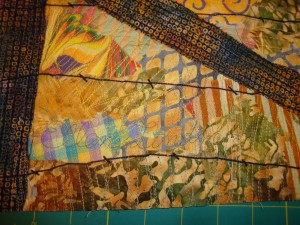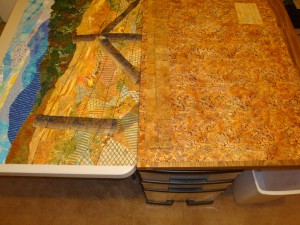Finishing Details: Mountain Meadow
I’m winding down on Mountain Meadow, so it’s time to add the facing and other finishing details. First, the signature. (You sign your quilts, right? I do, and I consider it an important part of completing the piece.)
I have a terrible time stitching my signature straight, so I rely on good ‘ole painters tape to give me a guideline. (Don’t stitch through the tape!)
Click any image for a larger view.
Choosing the best thread color for the signature is something I haven’t entirely mastered. I aim for enough contrast to show up, but not so much that it creates a distraction. In this case, I think the olive green I chose was not dark enough. (See what I mean? Click the photo if you want a better look.)
You’ll notice that I’m stitching the signature before facing the quilt. That avoids any potential thread problems that would otherwise show on the back.
I find the finishing details of quilt making to be a little tedious. After all, the fun was in the creative part! Therefore, I want to finish the quilt as easily and quickly as possible. So, I face all my quilts. With a little planning, I can actually machine sew the label and sleeve onto the facing before attaching it, and have NO hand sewing needed! Yahoo! (See the facing that’s ready to go in the photo below.)
I’ve actually created a finishing checklist, so I don’t forget anything. After all, this quilt will still need to be photographed and treated with a UV/Stain protectant. It’s easy to overlook such details, especially since I tend to do those last two tasks in batches. (My checklist is taped inside the door of my storage unit, in my studio.)
What are your favorite finishing techniques and tips? Do you sign your quilts? Why or why not?
Ellen Lindner
P.S. Want to face your own quilts? I highly recommend it. See this article/tutorial on my website, to learn how.
P.P.S. The finishing checklist is available on my website as either a Word document, or a PDF.




I agree with you, Ellen, signing is a vital part of the final few steps we take in finishing off a work. In the case of the meadow quilt I agree, perhaps the green you chose is a little too subtle, but on the other hand you could easily sew another line of slightly darker thread over it – or whip the stitches with a darker thread or a fine metallic one ….I sometimes fmq mine, sometimes sign with a fine black or brown fine permanent pen, and sometimes with a metallic gel-tip – it all depends on the quilt, the construction methods and the fabric. And, although I may have decided to face or bind, when I do actually get to that point I might change my mind. I often face, other times bind generally with a fine 1/4″ or so showing on front. It’s just what the quilt seems to require. But either way, I always stitch mine down by hand – I never understand p[eople like you who sound as if they will do almost anyhting to avoid hand sewing! I really enjoy making a fine quality hand finished edging. Anyway, I guess my main point is that there is always more than one way to do something and in the end, it is the maker who must make these decisions and whatever the final choice is, do it as well as possible.
Ellen, thanks for the great tips. And you, too, Alison!
I’ve never signed my quilts – I’ve only put my name on the label, but I think it’s a great idea. I’ll start doing that from now on.
And your check list is a great reminder. Like you said, sometimes the last chores (applying U/V protectant, for example) aren’t done right away, so the check list keeps things from falling through the cracks. Seems the older I get, the bigger those cracks get!
You are so clever – thanks for sharing your system.
Thanks for reminding me about the permanent pen option, Alison. That’s something I’ve used in the past, but had sorta forgotten about.
I don’t necessarily object to hand sewing, and this quilt has a lot of that on the FRONT. But, when it comes to finishing, I’m anxious to get onto the next project, so I’m looking for SPEED!
You’re definitely right that there are many ways to do things! We each have to experiment and see what works best for us. Thanks for commenting!
Hey Barb: glad to know I’m not the only one with “bigger cracks!”
Glad you found the post to be helpful, and that you’ll be signing your quilts!!!
Great Tute! Yes I always sign my work and label on the back. Placing your label before you face it is a great idea! Sometimes I just use a transfer. Sigh- backing is also one of my least favorite tasks as well!
You mention UV/Stain Protectant. Do you mind mentioning what you actually use for this and I’m assuming it’s spray that you do outside? Yes, I don’t actually do this step and never really thought of it. But I will from now on! So any tips would be appreciated and the check list is fantastic and a copy will go up in my studio as well!
I also tired of so much hand stitching at the end and have been using the pillowcase method and hiding my turning slit under the label. If I’m going to spend a lot of time doing hand stitching, I want it to show. Good idea to stitch the sleeve down before you add the backing. Quite the time saver! I don’t sign my work, but it does sound like a good idea. I’m going to think about that one.
Yes, Judy, avoiding the hand stitching is a huge time saver!
Debby, I use Quilt Protect, from Sullivan. However, it’s become extremely hard to find (at least in my area.) I still occasionally see it at Hancock’s Fabrics. (Not Hancock’s of Paducah.)